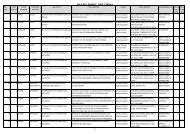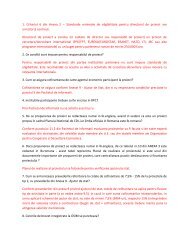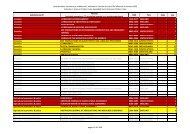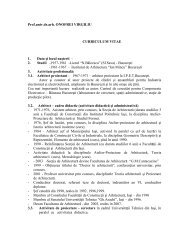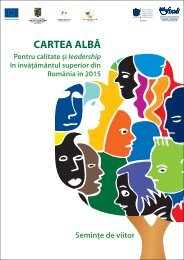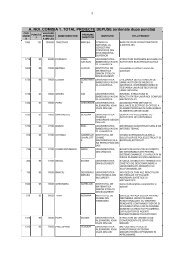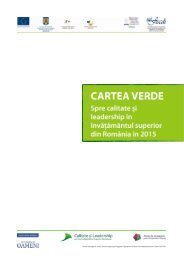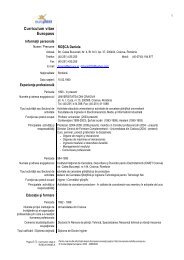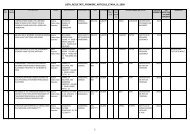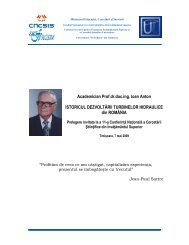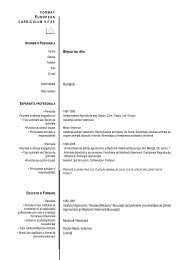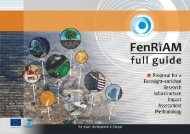Managementul activitatilor tertiare - uefiscdi
Managementul activitatilor tertiare - uefiscdi
Managementul activitatilor tertiare - uefiscdi
Create successful ePaper yourself
Turn your PDF publications into a flip-book with our unique Google optimized e-Paper software.
CS is committed to supporting positive community change at the individual, family,neighbourhood, and community level. As same as these areas, it is essential for Universities andtheir education systems in academic level. The first step is the identification of risk factors such asillegal applications, unhappy partners, insufficient academic personal or other sub-conditions,insufficient student care and protective factors such as perceived self efficacy, meaningfulconnections between adults, and positive role models in the perfected.Then, resources can be mobilized to reduce and eliminate those risk factors that threatenacademic stability and growth while fostering partnership protective factors and resources (e.g.,law enforcement and rehabilitation programs, work readiness programs) that can enhanceprograms, services, and opportunities (ausch and Patton 2004).Maor Process reas and an OverviewFor a comprehensive community such as universities, change through the CS process is based ona set of guiding principles:‣ CS is a grassroots, community-based initiative.‣ Community ownership and responsibility is essential.‣ The community is expert in guiding its own destiny.‣ Campus partnership supports community efforts.‣ Community collaborations support shared resources.‣ outh are active participants in community change.‣ Assessment and response is dynamic and ever changing.‣ Gather resources from local, state, and national partners.‣ Adopt and adapt best practices whenever possible.CS teams will probably find that their efforts in the first year can be sustained throughcommitted involvement of key community stakeholders and partnerships with universityspecialists. However, once a team has completed the needs assessment and identified keystrategies and plans of action, the team may begin thinking about ways to fund current and futurecommunity initiatives. Funds for community initiatives may come from coalition members.The Power of Partnerships at niversity ore and more funding agencies and organizations are asking communities to work together toaddress community needs through comprehensive efforts. Community partnerships supportshared resources and expertise, while reducing the likelihood of unnecessary duplication ofservices. CS is in a uniquely positive position to garner support from funding agencies interestedin comprehensive community collaborations. After all, the entire philosophy driving the CSinitiative is the power of grassroots, community-based collaborations working together to assesscommunity needs and address Universitys community issues, enhance resources, and support abetter quality of life for community residents. When soliciting support from funding agenciesthrough grants, gifts, or donations, highlight the partnerships established through the CSinitiative. Document how long organizations have acted in partnership, previous collaborationsand successes, and the history of positive projects and outcomes for the community.Guiding principles for developing and sustaining a strong CS team include:‣ Extension, law enforcement, and judge are committed.‣ CS training supports the community change process.‣ A community needs assessment guides team efforts.‣ A larger community coalition implements change.‣ Flexibility and accountability sustain efforts.Guiding principles surrounding best practices include (ausch and Patton 2004):‣ Determine desired outcomes or program needs.‣ Identify resources currently available.‣ esearch best practices.585References1. World University ankings (2005). The top 200 World University ankings. The Times HigherEducation Supplement, 10 (1), 1-15.2. eport on esearch Activities By IOC ember States, CO STECH, OIC Standing Committeeon Scientific and Technological Cooperation, February 2006.3. Intellectual Property Audit Tool, IP Assets Management Series, World Intellectual PropertyOrganization (WIPO), Geneva, Switzerland.4. Erdil, E., Bilsel, A. (2005). Curriculum design to revitalize electrical engineering education atEastern editerranean University. International Journal of Electrical Engineering Education, 42(3), 234-246.5. Akram Al-awi, Azzedine Lansari, and Faouzi Bouslama, “A Holistic Approach to Develop ISCurricula: Focusing on Accreditation and Certification Issues”, accepted for publication in theournal of Information Technology Education (ITE), Information Science Institute, USA.http://www.jite.org6. Azzedine Lansari, Fawzi Buslama, Akram Al-awi, and Abdullah Abonamah, “Using anOutcome Based odel to Foster Learning in Information Systems”, The 2003 ASEE Annualconference, Nashville, TN, une 22-25. http://www.asee.org/conferences/caps/document2/2003-744Paper.pdf7. . A. Khasawneh, Abdallah I. alkawi, Azzedine Lansari, ohammad alkawi, and Omar Al-arrah, “Towards Optimizing Engineering Education in Arab Universities Producing Industry-Oriented Outcomes, ” 4th International Forum on Engineering Education, Integrating Teaching &Research with Community Service, Sharjah, United Arab Emirates, April 2006.8. Faouzi Buslama, Azzedine Lansari, Akram Al-awi, and Abdullah Abonamah, “A NovelOutcome-Based Educational odel and it is effect on Students Learning, CurriculumDevelopment, and Assessment,” ournal of Information Technology Education (ITE), Vol.2,pp.203-214, 2003. http://www.jite.org/documents/Vol2/v2p203-214-22.pdf. IEEE Learning Technology Standards Committee (LTSC). Standard for Information Technology -- Education and Training Systems -- Learning Objects and Metadata (IEEE P1484.12) Online.Available: http://ltsc.ieee.org/wg12/index.htmlS P10. Willie D. ones, “IEEE to Beef Up its Global Accreditation ole,” The Institute, IEEE, September2006.60



